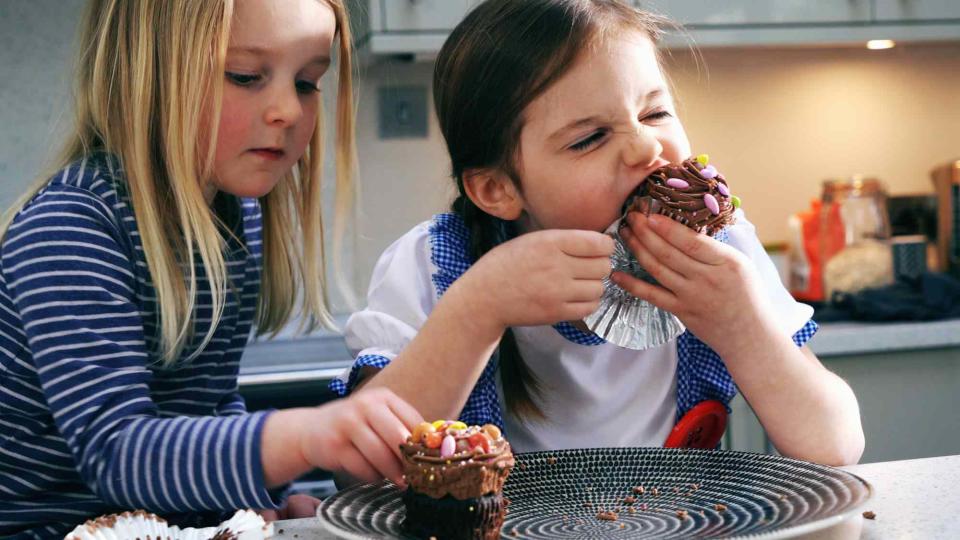7 Reasons Your Kid Is Always Hungry—and What To Do About It
Does it seem like your kid is constantly asking for food—even when they just ate? Here are six possible reasons why, and what to do about it.

Parenting can be repetitive, and that is particularly true at mealtime. Many feel like they are stuck in a cycle of making a meal. Clean up. Make a snack. Clean up. Make a meal again, and repeat forever. Sounds like you've got a hungry kid on your hands!
But children need to eat. From three square meals a day to multiple snacks, kids need a lot of food (and fuel) to keep up with their activity levels and help them grow. For some parents, the requests for food seem never-ending. One of the concerns I hear from parents is that their kids always seem hungry no matter what they do.
If there's been a big change in your child's appetite—either up or down—it's worth checking in with their pediatrician to make sure everything is okay. For example, if your child suddenly has an insatiable appetite that seems extreme for them or if they have lost their appetite altogether, it may be time to take a closer look with your child's doctor.
Assuming everything's normal, here are a few common culprits that could be the root of your child's seemingly bottomless pit.
Related: 13 Nutritionist-Approved Tips for Feeding Kids

Your Kid's Meals and Snacks Aren't Filling
A lot of common "kid food"—think fish-shaped crackers, gummy fruit snacks, and sugary granola bars—provide calories but aren't particularly satisfying, leaving you with a hungry kid asking for more. Ditto for foods made with refined flour, like white bread and pastries. That means that even right after eating them, your child may still be hungry. Kids who don't eat fruits and vegetables, which are full of hunger-busting fiber and fluid, may also find themselves less than satisfied.
What to do
Be sure meals include filling foods, like fiber-rich whole grains, proteins, fruits, and vegetables; after all, fiber plays an incredibly important role in nutrition. The same goes for snacks. It's okay to have empty-calorie foods like pretzels or white crackers sometimes, but the majority of snacks should be more like "meal foods" that contain filling nutrients.
Here are ten snacks that keep kids full:
Apple slices with peanut butter
Veggie sticks with hummus
Greek yogurt with granola and berries
Air-popped popcorn with nutritional yeast and Italian seasoning
Celery sticks with peanut butter and raisins
Cheese slices and whole wheat crackers
Smoothie with Greek yogurt, mixed fruit and berries, and milk
Tortilla roll-up with banana, peanut butter, and mini chocolate chips
Hard-boiled eggs, cheese cubes, and sliced-up veggies
Mini bagels with cream cheese
Related: Peanut-Free Snacks for School
Your Child Doesn't Like the Food They Eat
Kids are famous for their stubbornly adverse reactions to certain foods like vegetables. But the good news is that research has shown that kids—especially babies and toddlers—who have repeated exposures to a new food are more likely to accept it. So, if your hungry kid is asking for sugary snacks (that don't fill them up) and you're looking for a healthier alternative, the numbers are on your side; keep offering new flavors like fresh veggies and whole fruit along with something your child does enjoy, and you might be surprised that over time, they will start requesting those string beans or carrot sticks.
Your child's dental health may partly depend on how much sugary food your child consumes, too. According to the American Dental Association, teeth are constantly getting coated in a sticky, bacteria-filled substance called plaque. When you eat foods—especially sugar—the bacteria in that plague ramp up acid production, which eats away at tooth enamel.
What to do
Fielding non-stop requests for snacks can be challenging, especially when your child refuses to eat the snacks you give them. Sometimes, a little compromise can go a long way, though. For example, if your child only wants gummy fruit snacks (and who can blame them, those little pouches are delicious!), try offering fresh berries or whole fruit instead. Here are some other tips that might help:
Out of sight, out of mind: Stop buying snacks you don't want your child to eat. If they're not in the house, they're not an option.
A plate of small things: Make eating snacks fun by offering up finger-sized pieces of fresh fruit, crackers, cheese cubes, veggies, and other stuff on a plate. Your child will have lots of options and get some nutrient-dense fuel at the same time. Win-win!
Schedule snack time: Some kids like to graze snacks all day, but that can be problematic for their appetite when it comes to mealtime. Try creating a routine schedule of snack times that your child can anticipate. It may even be helpful to have your child help plan snacks for the week so they feel like they have some control over what you put on their plate.
Enlist your child in making snacks: Turn snack time into a fun kitchen adventure by having your child help prepare their food. Your child might be more likely to eat their creation is they had a hand in making it.
They're Having a Growth Spurt
Kids' appetites fluctuate from year to year and even day to day. Toddlers and preschoolers, for example, are notorious for eating very little one day and loads of food the next. When children are hitting a growth spurt, there's a sudden uptick in appetite that may seem out of character—and even hard to satisfy! The good news? It's totally normal.
During growth spurts, you can help support your child's growing bones by adding lots of protein and calcium to their diet, including snacks. According to the National Institute of Arthritis and Musculoskeletal and Skin Diseases, bones are living tissue that needs calcium and vitamin D to help support growth and health, and by starting kids off with excellent eating habits in childhood, they can potentially avoid or lower their risk of osteoporosis later in life.
What to do
Handle these surges in appetite with nourishing, satisfying food. Be sure your kitchen is stocked with healthy, easy options like nut butter, cheese, edamame, avocado, and whole grains so hungry kids are reaching for nutritious foods instead of chips or sweets.
Also, consider beefing up their mealtimes with foods rich in vitamin D and calcium to help support growing bodies—and bones.
Your Child Is Eating Out of Boredom
Emotional eating isn't just for grown-ups. "Sometimes for a kid 'I'm hungry' means I'm bored, upset, nervous, or just want to eat," says Maryann Jacobsen, MS, RD, author of How to Raise A Mindful Eater.
But your child may also associate food with comfort. Research shows that how parents and caregivers model emotional regulation through eating behaviors can directly impact how children approach food too. While "stress eating" isn't always bad—who doesn't love eating comfort foods like baked macaroni and cheese or freshly baked chocolate chip cookies once in a while?—Emotional eating on a regular basis could potentially create unhealthy eating habits in adults and kids.
What to do
Start talking with your child about hunger, fullness, and the importance of listening to our bellies. If it turns out your child is not very hungry, you may want to ask them what they're really feeling and try to help—whether it's talking through a problem or finding a book or game if they're bored. Scheduled meals and snacks can also help. "Having regular, structured meals at the table without grazing in between helps keep the child from learning to eat for non-food reasons," says Jacobsen.
Try a few of these boredom busters to help your child make healthier choices when they have nothing "fun" to do:
Create a game center: Grab a bin or a shelf on a bookcase and load it up with fun, age-appropriate games and puzzles that your child can pull out any time they wish.
Try a book nook: If your child loves to read (or is learning to read and loves to look at picture books!), try finding some creative places for them to curl up with a good book, like building a pillow fort on the couch, or a reading cave under a table.
Arts and crafts: Keep a shoebox or basket filled with washable crayons and markers, coloring books, play dough, safety scissors, and other artsy things handy. When your child feels bored, challenge them to create something interesting.
Dress-up box: Save old Halloween costumes and other fun dress-up things like costume jewelry, gloves, hats, etc., and keep them in a dress-up box to give your kiddo a super fun option for engaging in creative play.
Schedule some play dates: If your child is regularly feeling bored, consider scheduling some play dates with friends or signing up for age-appropriate activities like reading time at your local library.
Hunger Is Being Confused With Thirst
It's not uncommon for thirst to be mistaken for hunger. Kids often get so caught up in playing that they forget to keep drinking, especially in hot weather. Hunger and thirst are complicated signals that are controlled by the nervous system and detected by the brain, which may explain why it is easy for kids (and adults too) to sometimes confuse thirst for hunger.
What to do
Have a designated water bottle or cup for your child that can be refilled throughout the day. Create and stick to a regular meal and snack schedule to ensure that your child is getting enough to eat each day; this way, when they say they're hungry, you can troubleshoot. For example, maybe lunch was running a bit late, or that healthy snack just didn't hit the spot.
Explain to your kids that sometimes thirst can feel like hunger. If they're truly hungry, serving a healthy snack is fine, but it's smart to check in about thirst, too. Just as you create a schedule for eating, it's helpful to have guidelines for how much water your child should be drinking throughout the day. Here's what the American Academy of Pediatrics (AAP) suggests for water intake for babies, toddlers, and older kids:
Age | Amount of fluids (water or milk) |
6 to 12 months | 4 to 8 ounces per day |
1 to 3 years | 4 cups per day |
4 to 8 years | 5 cups per day |
9 years and up | 7 to 8 cups per day |
Related: How Much Water Should Kids Drink and Tips to Keep Them Hydrated
Your Family Faces Food Insecurity
Food insecurity is a growing global problem that deeply impacts families and communities. One in seven American kids faces the challenges of food insecurity, which is why the AAP encourages doctors to screen families about their socioeconomic status, including unmet needs. From there, doctors can connect families to resources such as local food cupboards and advocate for them through local, state, and federal channels.
No family should go hungry. If your family is dealing with food insecurity, talk to your pediatrician. You can also visit the US Department of Agriculture (USDA) for a full list of food assistance programs that may help.
Key Takeaways
Kids and snacks go together like peanut butter and jelly, but for parents, the non-stop requests for more food can leave them asking why? The truth is that kids' bodies need plenty of healthy, nutrient-dense calories to support growth. But kids also need boundaries to help[ them make smart, healthy choices when it comes to what (and when) they fill their plate. By using simple strategies like meal planning and open lines of communication about hunger, you can help your kid learn how to listen to their bodies.
For more Parents news, make sure to sign up for our newsletter!
Read the original article on Parents.

